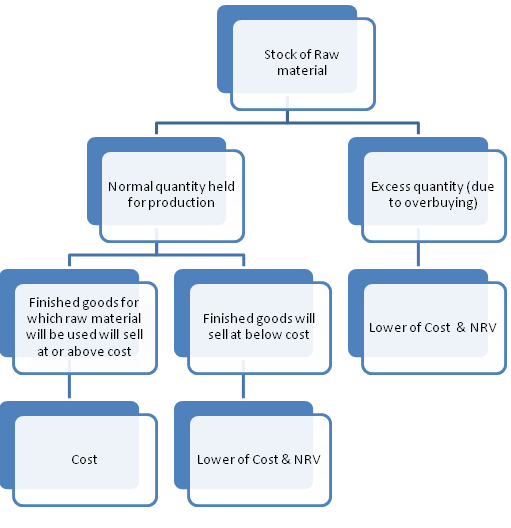VALUATION OF
INVENTORIES – AS -2
INVENTORIES: It is defined as "A company’s merchandise, raw materials, finished & unfinished products
which have not yet been sold." These are considered liquid assets, since they
can be converted into cash quite easily. It includes finished goods, work-
in-progress, raw material, consumables, loose tools, etc., which are held for
resale or consumption.
Inventories should be valued at the lower of COST and NET REALIZABLE VALUE.
· COST: cost of purchase + cost of conversion + other
cost incurred to bring the inventory to its present location and condition.
· Cost of Purchase: It includes taxes, duties (except which
are later on recoverable by the enterprise from taxing authorities), freight
inward etc. Trade discount, rebate, duty drawback etc. will be deducted.
Cenvatable excise duty paid on inputs is excluded.
·
Cost of Conversion: It includes labour cost, fixed and
variable production overheads.
Ø Fixed production overhead: It should be allocated on the basis of normal
capacity. Actual production can be used if it approximates the normal capacity.
In
case of low production the unabsorbed fixed overhead will not be allocated to
inventory cost. But in case of abnormally high production the inventory cost
will be appropriately reduced so as to include actual fixed overhead over total
production.
· In case of joint products, joint cost should be allocated on some
reasonable and consistent bases. E.g. their respective sales valued at
separation stage or after further processing.
·
In case of by products, scraps etc.: If not very significant are
valued at net realizable value and this value is deducted from the cost of main
product.
·
Following should not be included in cost of inventory
Ø Storage cost
Ø Administrative overhead
Ø Selling and distribution cost
Ø Abnormal losses / wastages
Ø Interest and other borrowing cost
·
Specific pricing is applied for items that are not interchangeable and
goods and services which are produced and segregated for a specific purpose /
project.
·
Cost should be calculated by FIFO or weighted average method. Weighted
average can be calculated after every lot is received or on periodic basis.
i.e. periodic weighted average method.
·
Standard cost or retail method can be used for convenience if results
approximate the actual cost.
·
Comparison of cost and net realizable value should be done on item
basis or similar and interchangeable items can be grouped (i.e. group basis but
not on aggregate basis i.e. global basis) But it should not be based on a
classification like all finished goods, all raw materials, etc.
·
Net realizable value estimation will also consider the purpose for
which inventory is held. In case of firm contracts for sales, the contract
price and for the excess inventory general selling price will be considered.
Contingent loss on firm contract in excess of inventory held will be provided
as AS-4
·
Material and other supplies held for use in the production of
inventories will generally be not valued below the cost if the net realizable value
of finished goods for which such material is going to be used will be equal to
or above the cost. Otherwise if material prices decline, the same will be
valued at lower than cost (which can be replacement cost.) Normal stock will
have to be written down to NRV if finished goods will sell at a loss. This is
because if the loss making finished goods is discontinued, stocks of raw
materials have to be sold off.
·
Disclosure in the financial statement in respect of AS -2 :
Ø Accounting policy adopted in measuring
inventories
Ø Cost formula used
Ø Classification of inventories: like
finished goods, WIP, raw material, spare parts and its carrying amount.
·
Summary :
Ø In case of high production, the overhead
should be allocated on the basis of actual production.
Ø Royalty based on production is part of
cost of inventory but royalty based on sale is not.
Ø Excise duty, paid or payable, in respect
of inventory of finished goods is a part of cost.
Ø Inventories be valued at cost net of ‘CENVAT’
credit.
Ø For buyer, the goods in transit are
included in inventory, only if the risk and rewards of ownership have passed to
him. If not, it is the inventory of the seller.
Ø Material given on loan is not an
inventory. Rather, it should be shown as Loans and Advances.
Ø Net realizable value should be estimated
at each balance sheet date.
Tree Diagram – Valuation of Stock of Raw
Material
 |
| Valuation of Stock of Raw Material |
Books
referred: Students’ guide to Accounting Standards

No comments:
Post a Comment